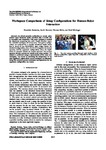Workspace comparisons of setup configurations for human-robot interaction
| dc.contributor.author | Zacharias, F | |
| dc.contributor.author | Howard, Ian | |
| dc.contributor.author | Hulin, T | |
| dc.contributor.author | Hirzinger, G | |
| dc.date.accessioned | 2019-10-22T12:35:43Z | |
| dc.date.available | 2019-10-22T12:35:43Z | |
| dc.date.issued | 2010-10 | |
| dc.identifier.isbn | 9781424466757 | |
| dc.identifier.issn | 2153-0858 | |
| dc.identifier.uri | http://hdl.handle.net/10026.1/15022 | |
| dc.description.abstract |
In virtual assembly verification or remote maintenance tasks, bimanual haptic interfaces play a crucial role in successful task completion. This paper proposes a method for objectively comparing how well a haptic interface covers the reachable workspace of human arms. Two system configurations are analyzed for a recently introduced haptic device that is based on two DLR-KUKA light weight robots: the standard configuration, where the device is opposite the human operator, and the ergonomic configuration, where the haptic device is mounted behind the human operator. The human operator directly controls the robotic arms using handles. The analysis is performed using a representation of the robot arm workspace. The merits of restricting the comparisons to the most significant regions of the human workspace are discussed. Using this method, a greater workspace correspondence for the ergonomic configuration was shown. ©2010 IEEE. | |
| dc.format.extent | 3117-3122 | |
| dc.language.iso | en | |
| dc.publisher | IEEE | |
| dc.title | Workspace comparisons of setup configurations for human-robot interaction | |
| dc.type | conference | |
| dc.type | Conference Proceeding | |
| plymouth.author-url | https://www.webofscience.com/api/gateway?GWVersion=2&SrcApp=PARTNER_APP&SrcAuth=LinksAMR&KeyUT=WOS:000287672000032&DestLinkType=FullRecord&DestApp=ALL_WOS&UsrCustomerID=11bb513d99f797142bcfeffcc58ea008 | |
| plymouth.date-start | 2010-10-18 | |
| plymouth.date-finish | 2010-10-22 | |
| plymouth.conference-name | 2010 IEEE/RSJ International Conference on Intelligent Robots and Systems (IROS 2010) | |
| plymouth.publication-status | Published | |
| plymouth.journal | 2010 IEEE/RSJ International Conference on Intelligent Robots and Systems | |
| dc.identifier.doi | 10.1109/iros.2010.5649207 | |
| plymouth.organisational-group | /Plymouth | |
| plymouth.organisational-group | /Plymouth/Faculty of Science and Engineering | |
| plymouth.organisational-group | /Plymouth/Faculty of Science and Engineering/School of Engineering, Computing and Mathematics | |
| plymouth.organisational-group | /Plymouth/REF 2021 Researchers by UoA | |
| plymouth.organisational-group | /Plymouth/REF 2021 Researchers by UoA/UoA11 Computer Science and Informatics | |
| plymouth.organisational-group | /Plymouth/Users by role | |
| plymouth.organisational-group | /Plymouth/Users by role/Academics | |
| dc.rights.embargoperiod | Not known | |
| rioxxterms.versionofrecord | 10.1109/iros.2010.5649207 | |
| rioxxterms.licenseref.uri | http://www.rioxx.net/licenses/all-rights-reserved | |
| rioxxterms.type | Conference Paper/Proceeding/Abstract |


